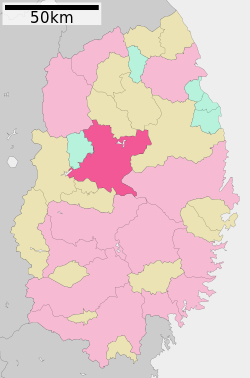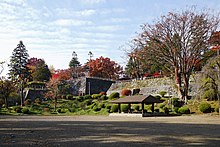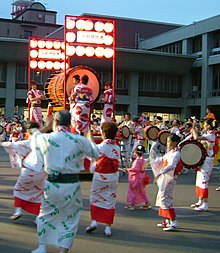You can help expand this article with text translated from the corresponding article in Japanese. (September 2018) Click for important translation instructions.
|
| Morioka 盛岡市 | |
|---|---|
| Core city | |
 Morioka City Montage Morioka City Montage | |
 Flag Flag Seal Seal | |
| Map of Iwate Prefecture with Morioka highlighted in pink | |
 | |
 | |
| Coordinates: 39°42′7.5″N 141°09′16.2″E / 39.702083°N 141.154500°E / 39.702083; 141.154500 | |
| Country | Japan |
| Region | Tōhoku |
| Prefecture | Iwate |
| First official recorded | 4th century AD |
| City Settled | April 1, 1889 |
| Government | |
| • Mayor | Shigeru Uchidate (from September 2023) |
| Area | |
| • Total | 886.47 km (342.27 sq mi) |
| Population | |
| • Total | 283,981 |
| • Density | 320/km (830/sq mi) |
| Time zone | UTC+9 (Japan Standard Time) |
| Symbols | |
| • Tree | Katsura |
| • Flower | Rabbit-ear iris |
| • Bird | Wagtail |
| Phone number | 019-651-4111 |
| Address | 12-2 Uchimaru, Morioka-shi, Iwate-ken 020-8530 |
| Website | Official website |
Morioka (盛岡市, Morioka-shi) is the capital city of Iwate Prefecture located in the Tōhoku region of northern Japan. On 1 August 2023, the city had an estimated population of 283,981 in 132,719 households, and a population density of 320 per square kilometre (830/sq mi). The total area of the city is 886.47 square kilometres (342.27 sq mi).
Geography
Morioka is located in the Kitakami Basin [ja] in central Iwate Prefecture, at the confluence of three rivers, the Kitakami, the Shizukuishi and the Nakatsu. The Kitakami River is the second largest river on the Pacific side of Japan (after the Tone River) and the longest in the Tōhoku region. It runs through the city from north to south and has a number of dams within the city boundaries, including the Shijūshida Dam and Gandō Dam. An active volcano, Mount Iwate, dominates the view to the northwest of the city. Mount Himekami is to the north and Mount Hayachine can sometimes be seen to the southeast.
Surrounding municipalities
Iwate Prefecture
Demographics
Per Japanese census data, the population of Morioka peaked at around the year 2000 and has slightly declined since.
| Year | Pop. | ±% |
|---|---|---|
| 1960 | 155,575 | — |
| 1970 | 226,868 | +45.8% |
| 1980 | 272,814 | +20.3% |
| 1990 | 292,632 | +7.3% |
| 2000 | 302,857 | +3.5% |
| 2010 | 298,572 | −1.4% |
| 2020 | 289,731 | −3.0% |
Climate
Morioka has a cold, humid continental climate (Köppen Dfa) characterized by warm, short summers and long, cold winters with heavy snowfall. The average annual temperature in Morioka is 10.2 °C (50.4 °F). The average annual rainfall is 1,314 millimetres (51.7 in) with July as the wettest month. The temperatures are at their highest on average in August, at around 23.7 °C (74.7 °F), and lowest on average in January, at around −2.4 °C (27.7 °F).
| Climate data for Morioka (1991−2020 normals, extremes 1923−present) | |||||||||||||
|---|---|---|---|---|---|---|---|---|---|---|---|---|---|
| Month | Jan | Feb | Mar | Apr | May | Jun | Jul | Aug | Sep | Oct | Nov | Dec | Year |
| Record high °C (°F) | 13.2 (55.8) |
15.2 (59.4) |
21.0 (69.8) |
29.0 (84.2) |
33.6 (92.5) |
33.7 (92.7) |
37.2 (99.0) |
36.6 (97.9) |
34.7 (94.5) |
29.2 (84.6) |
21.3 (70.3) |
17.9 (64.2) |
37.2 (99.0) |
| Mean daily maximum °C (°F) | 2.0 (35.6) |
3.2 (37.8) |
7.5 (45.5) |
14.4 (57.9) |
20.3 (68.5) |
24.1 (75.4) |
27.1 (80.8) |
28.4 (83.1) |
24.3 (75.7) |
17.9 (64.2) |
10.9 (51.6) |
4.5 (40.1) |
15.4 (59.7) |
| Daily mean °C (°F) | −1.6 (29.1) |
−0.9 (30.4) |
2.6 (36.7) |
8.7 (47.7) |
14.5 (58.1) |
18.8 (65.8) |
22.4 (72.3) |
23.5 (74.3) |
19.3 (66.7) |
12.6 (54.7) |
6.2 (43.2) |
0.8 (33.4) |
10.6 (51.1) |
| Mean daily minimum °C (°F) | −5.2 (22.6) |
−4.8 (23.4) |
−1.8 (28.8) |
3.2 (37.8) |
9.1 (48.4) |
14.2 (57.6) |
18.8 (65.8) |
19.8 (67.6) |
15.2 (59.4) |
7.9 (46.2) |
1.8 (35.2) |
−2.5 (27.5) |
6.3 (43.3) |
| Record low °C (°F) | −20.6 (−5.1) |
−17.7 (0.1) |
−17.1 (1.2) |
−7.8 (18.0) |
−2.0 (28.4) |
1.3 (34.3) |
4.3 (39.7) |
7.4 (45.3) |
2.5 (36.5) |
−3.4 (25.9) |
−8.6 (16.5) |
−17.7 (0.1) |
−20.6 (−5.1) |
| Average precipitation mm (inches) | 49.4 (1.94) |
48.0 (1.89) |
82.1 (3.23) |
85.4 (3.36) |
106.5 (4.19) |
109.4 (4.31) |
197.5 (7.78) |
185.4 (7.30) |
151.7 (5.97) |
108.7 (4.28) |
85.6 (3.37) |
70.2 (2.76) |
1,279.9 (50.39) |
| Average snowfall cm (inches) | 63 (25) |
55 (22) |
39 (15) |
3 (1.2) |
0 (0) |
0 (0) |
0 (0) |
0 (0) |
0 (0) |
0 (0) |
6 (2.4) |
44 (17) |
209 (82) |
| Average precipitation days (≥ 0.5 mm) | 11.9 | 10.5 | 13.2 | 12.2 | 12.3 | 10.5 | 14.6 | 12.5 | 12.5 | 12.4 | 13.8 | 12.6 | 149.0 |
| Average relative humidity (%) | 73 | 71 | 67 | 65 | 68 | 74 | 80 | 79 | 80 | 78 | 76 | 75 | 74 |
| Mean monthly sunshine hours | 115.6 | 124.8 | 157.8 | 171.4 | 188.0 | 161.3 | 130.5 | 145.3 | 128.8 | 141.3 | 117.7 | 103.7 | 1,686.3 |
| Source: Japan Meteorological Agency | |||||||||||||
History

The area of present-day Morioka has been continuously inhabited since the Japanese Paleolithic period. Numerous Jōmon, Yayoi and Kofun period tombs and remains have been found. The Emishi inhabited the area into the Heian period. During the Enryaku era of the Heian period, Sakanoue no Tamuramaro, was ordered north to Shiwa Castle in 803 AD, as a military center to extend the domination of the imperial dynasty over Mutsu Province. The area was later ruled by the Abe clan until their destruction during the Former Nine Years War at the hands of the Minamoto and Kiyohara clans. The Kiyohara were in turn defeated in the Gosannen War and the area came under the control of the Ōshū Fujiwara Clan based in Hiraizumi, to the south of Morioka. After the Ōshū Fujiwara were destroyed by Minamoto no Yoritomo at the start of the Kamakura period, the area was disputed by several samurai clans until the Nanbu clan, based in Sannohe to the north, expanded their territory during the Sengoku period and built Kozukata Castle in 1592.
Following the Battle of Sekigahara and the formal recognition of Morioka Domain under the Tokugawa shogunate, Kozukata Castle was renamed Morioka Castle. Its name was changed from 森岡 to 盛岡 (both read as "Morioka") During the Boshin War of the Meiji Restoration, Morioka Domain was a key member of the pro-Tokugawa Ōuetsu Reppan Dōmei.
After the start of the Meiji period, the former Morioka Domain became Morioka Prefecture in 1870, and part of Iwate Prefecture from 1872. With the establishment of the modern municipality system on April 1, 1889, the city of Morioka was established as the capital of Iwate Prefecture. The city was connected by train to Tokyo in 1890. The city emerged from World War II with very little damage, having been subject to only two minor air raids during the war.
On January 10, 2006, the village of Tamayama was merged into Morioka. Morioka was proclaimed a core city in 2008, with increased local autonomy.
During the 2011 Tōhoku earthquake, Morioka was hit by a 6.1 earthquake, and numerous aftershocks, but with little damage other than extensive power outages.
Government

Morioka has a mayor-council form of government with a directly elected mayor and a unicameral city legislature of 38 members. Morioka contributes ten seats to the Iwate Prefectural legislature. In terms of national politics, the town is part of Iwate first district of the lower house of the Diet of Japan.
Education
Colleges and university
High schools
Morioka has eight public high schools operated by the Iwate Prefectural Board of Education.
- Morioka First High School
- Morioka Second High School
- Morioka Third High School
- Morioka Fourth High School
- Morioka South High School
- Morioka Agricultural High School
- Morioka Industrial High School
- Morioka Commercial High School
There is also one public high school operated by the city government and ten private high schools
Transportation
Railway
[REDACTED] East Japan Railway Company (JR East) - Tōhoku Shinkansen
[REDACTED] East Japan Railway Company (JR East) - Tōhoku Main Line
- Iwate-Iioka - Senbokuchō - Morioka
[REDACTED] East Japan Railway Company (JR East) - Tazawako Line (Akita Shinkansen)
- Morioka - Maegata
[REDACTED] East Japan Railway Company (JR East) - Yamada Line
- Morioka - Kamimorioka - Yamagishi - Kamiyonai
[REDACTED] East Japan Railway Company (JR East) - Hanawa Line
- Morioka - Kōma
- Morioka – Aoyama – Kuriyagawa – Shibutami – Kōma
Highway
 Tōhoku Expressway – Morioka-Minami IC, Morioka IC
Tōhoku Expressway – Morioka-Minami IC, Morioka IC National Route 4
National Route 4 National Route 46
National Route 46 National Route 106
National Route 106 National Route 281
National Route 281 National Route 282
National Route 282 National Route 396
National Route 396 National Route 455
National Route 455 National Route 456
National Route 456
Local attractions
- The Iwate Museum of Art in Morioka displays works by three notable local artists, Tetsugoro Yorozu, Shunsuke Matsumoto and Yasutake Funakoshi, as well as holding exhibitions on national and international themes.
- Rock-Breaking Cherry Tree - designated a natural monument of Japan.
- Iwate Prefectural Museum
- Site of Morioka Castle, National Historic Site
- Shiwa Castle ruins, National Historic Site
- Bank of Iwate Red Brick Building, Important Cultural Property
- Morioka Hachimangū
Sports
Sports venues
Sports teams
- Iwate Big Bulls, basketball team
- Iwate Grulla Morioka, football team
Religion
Temples and shrines

- Hōon-ji is a Sōtō Zen Buddhist temple which was originally built at Sannohe by the 13th lord of the Nambu clan, Nambu Moriyuki, in 1394, and brought to Morioka by the 27th lord, Nambu Toshinao. It was considered the head temple among the 280 operated by the Nambu clan. A notable feature is the Rakan-dō, built in 1735 and rebuilt in 1858. Its central statue Rushana butsu is reported to be made by Kōbō-daishi. Within the Rakan-dō are statues of the 500 Rakan, which were made in Kyoto and later brought to Morioka. Included are representations of Kublai Khan and Marco Polo. It is an active Zen training temple for monks.
- Mitsuishi Jinja is a Shinto shrine which has three large rocks on the grounds with shackles around them to represent the story of 'Oni no tegata', which is a legend explaining the origin of the name of Iwate prefecture. According to the legend, there was once an Oni or demon who often tormented and harassed the local people. When the people prayed to the spirit of Mitsuishi for protection, the demon was immediately shackled to the rocks and made to promise never to trouble the people again. As a sign of this promise, the demon left a handprint on one of the rocks, thus giving rise to the name Iwate, literally meaning "rock hand".
- Morioka Hachiman Shrine
- Sakurayama is a Shinto shrine 20 feet above (6 meters) featuring a massive rock.
Cuisine
Morioka attracts tourists with local noodles such as jajamen, reimen, and wanko soba. Brewing is also a thriving industry of the city. Nambu senbei, a type of rice cracker, is considered a local specialty.
Media
- Iwate Asahi Television
- Iwate Broadcasting Company
- Iwate Menkoi Television
- Iwate Nippo
- Television Iwate
International relations
 Victoria, British Columbia, Canada (sister city since 1985)
Victoria, British Columbia, Canada (sister city since 1985)
Notable people
| This section needs additional citations for verification. Please help improve this article by adding citations to reliable sources in this section. Unsourced material may be challenged and removed. (July 2013) (Learn how and when to remove this message) |
- The Great Sasuke, professional wrestler
- Takuboku Ishikawa, poet
- Takuya Kawamura, professional basketball player
- Yusei Kikuchi, professional baseball player
- Taka Michinoku, professional wrestler
- Yōko Mihara, actress
- Milano Collection A.T., professional wrestler
- Inazō Nitobe, author, educator, diplomat, and politician during the Meiji period and Taishō period
- Mitsuo Ogasawara, footballer
- Takatō Ōshima, engineer - made the first Western-style cannon in Japan
- Mikoi Sasaki, actress
- Yota Sato (boxer), professional boxer
- Hara Takashi, former Prime Minister of Japan
- Nishikigi Tetsuya, sumo wrestler
- Mitsumasa Yonai, former Prime Minister of Japan
References
- Morioka City official statistics (in Japanese)
- Morioka population statistics
- Morioka climate data
- 気象庁 / 平年値(年・月ごとの値). Japan Meteorological Agency. Retrieved May 19, 2021.
- https://twitter.com/sayakasofiamori/status/1759319506797875444
- 不来方 [Kozukata]. Dijitaru Daijisen (in Japanese). Tokyo: Shogakukan. 2013. OCLC 56431036. Archived from the original on 2007-08-25. Retrieved 2013-02-01.
- "【地名の由来】市名". Archived from the original on 2014-03-16. Retrieved 2013-09-07.
- Ministry of Home Affairs of Japan (in Japanese)
- http://www.marketwatch.com/story/new-61-magnitude-quake-hits-near-morioka-japan-2011-03-11 - retrieved March 14, 2011
- Morioka Castle Ruins Agency for Cultural Affairs (in Japanese)
- "志波城跡 しわじょうあと". Cultural Heritage Online (in Japanese). Agency for Cultural Affairs. Retrieved 25 December 2016. (in Japanese)
- "岩手銀行(旧盛岡銀行)旧本店本館". Cultural Heritage Online (in Japanese). Agency for Cultural Affairs. Retrieved 25 April 2020. (in Japanese)
- "International Exchange". List of Affiliation Partners within Prefectures. Council of Local Authorities for International Relations (CLAIR). Archived from the original on 22 December 2015. Retrieved 21 November 2015.
- ミラノコレクションA.T. [Milano Collection A.T.]. New Japan Pro-Wrestling (in Japanese). Archived from the original on 2010-06-18. Retrieved 2014-02-03.
- Tucker, Spencer (2005). World War I: Encyclopedia, Volume 1. Santa Barbara: ABC-CLIO. p. 539. ISBN 978-1851094202.
External links
 Morioka travel guide from Wikivoyage
Morioka travel guide from Wikivoyage- Official Website (in Japanese)
| Morioka (capital) | ||
| Core city | ||
| Cities | ||
| Districts | ||
| List of mergers in Iwate Prefecture | ||
| Metropolitan cities of Japan | |
|---|---|
| also a prefectural capital; eligible for core city status but not yet nominated; to become core cities |


